Microsoft Management Console Basics
The Microsoft Management Console (MMC) is a powerful addition to the system administrator's arsenal. The MMC works as a packager of system tools, enabling the system administrator to create specialized tools that can then be used to delegate specific administrative tasks to users or groups. Saved as MMC (.MSC) files, these custom tools can be sent by e-mail, shared in a network folder, or posted on the Web. With system policy settings, they can also be assigned to users, groups, or computers. The tools are flexible enough to be modified, scaled up or down, and generally shaped for any use to which you might want to put them.
To build a custom tool, you can either start with an existing console and modify it or start from scratch. In a mature network, you'll most likely use the former method, taking predefined consoles and adding or subtracting snap-ins.
Creating an MMC-Based Console with Snap-ins
Building your own tools with the MMC's standard user interface is a straightforward process. The next few sections walk you through the creation of a new console and describe how to arrange its administrative components into separate windows.
- Click the Start button and select Run. In the Open text box, type MMC, and then click OK. An empty MMC window opens, as shown in Figure 10-3, ready for you to add snap-ins.
- From the Console menu, select Add/Remove Snap-in. (The menu commands on the menu bar at the top of the MMC window apply to the entire console.) The Add/Remove Snap-in dialog box opens. Here you can choose which snap-ins are in the console file as well as enable extensions. In the Snap-ins Added To box, accept the default, Console Root.
- Click the Add button. This opens a dialog box listing the snaps-ins installed on your computer (Figure 10-4).
- Highlight a snap-in to see a description of its function. Double-click a snap-in to add it to the console. For this example, we'll add Computer Management. The Computer Manager dialog box asks you to select the computer to manage (Figure 10-5).
- Select the Local Computer option, and select the check box Allow The Selected Computer To Be Changed When Launching From The Command Line. These options are common to many of the snap-ins. Click Finish.
- From the Add Standalone Snap-in dialog box, select Event Viewer, and click Add. As before, select the Local Computer option, and select the check box. Click Finish, then close the list of available snap-ins. The Add/Remove Snap-in dialog box lists two snap-ins: Computer Management (Local) and Event Viewer (Local).
- Click the Extensions tab. By default, the box labeled Add All Extensions is checked, which means that when this console is opened on a particular machine, all extensions that are locally installed on that machine will be used. If this box isn't checked, only extensions that are selected on the list of available extensions will be loaded.
- Click OK to close the Add/Remove Snap-in dialog box. The Console Root window now has two snap-ins, rooted at the Console Root folder.
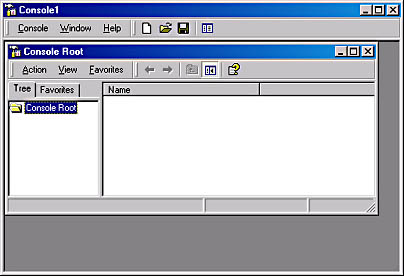
Figure 10-3. An empty MMC window.
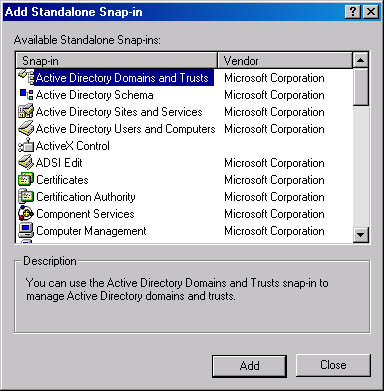
Figure 10-4. The Add Standalone Snap-in dialog box.
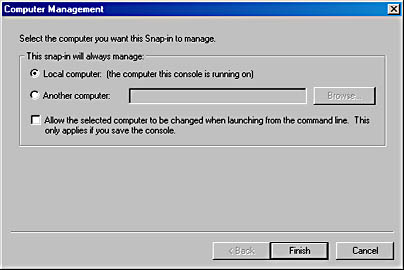
Figure 10-5. The Computer Management dialog box for the Computer Management snap-in.
Save the console by choosing Save from the Console menu. You will be prompted for a name—be as descriptive as possible. The file is saved in the Administrative Tools folder by default. This folder is part of your profile, so an added benefit is that if you use roaming profiles, any tools you create will go with you. See Chapter 9 for information on creating roaming profiles.
Customizing the Layout of a Console
Once you've added the snap-ins, you can provide different administrative views in the console by adding windows. To create one window for each of the snap-ins, follow these steps:
- In the left pane of the console window, right-click the Computer Management folder and select New Window From Here. This opens a new Computer Management window rooted at the Computer Management snap-in.
- In the Console Root window, right-click the Event Viewer folder and select New Window From Here. Click the Show/Hide Console Tree toolbar button in each window to hide the console tree (Figure 10-6).
- Close the original Console Root window. From the Window menu, choose Tile Horizontally. The console window should now look like Figure 10-7.
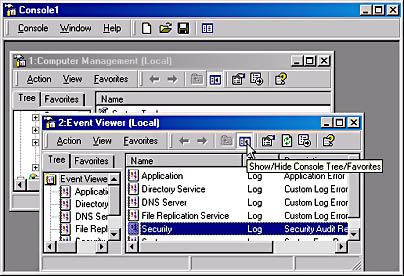
Figure 10-6. The Show/Hide Console Tree button.
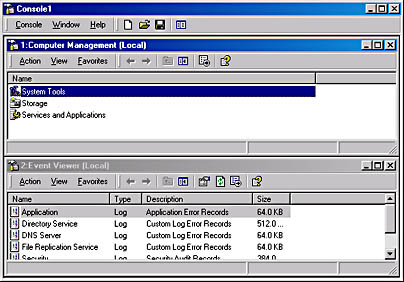
Figure 10-7. The console with tiled windows.
Note that the buttons and menus in each window apply only to that window. Remember to save your console file after completing the changes.
Setting Options for a Console File
When creating consoles for workgroup managers or other users, you may want to restrict how the console is used. Console options can be set so that users can access only the tools that the administrator allows. To set console file options, follow these steps:
- With the console file open, click the Console menu and choose Options. This opens the Options dialog box.
- Click the Console tab. Choose the console mode:
- Author Mode No restrictions. The user can access all parts of the console tree as well as change this console file at will.
- User Mode—Full Access The user can access all parts of the console tree but cannot make changes that affect functionality. Cosmetic changes, such as the arrangement of windows, are saved automatically.
- User Mode—Limited Access, Multiple Window The user can access only the parts of the console that were visible at the time the console file was saved.
- User Mode—Limited Access, Single Window The same as the previous mode, except that only one window is visible.
- In all but Author mode, you can also select the Do Not Save Changes To This Console option, so that the console always opens in the same view.
- Click OK and save the console file.
Modifying Console Files
After you've saved a console file in any mode other than Author mode, the Console menu is no longer visible, even to administrators. This prevents the user from changing the options. To modify a console file, open a command-prompt window and type mmc /a. The /a switch sets Author mode, overriding any User mode setting, and opens the console window, from which you can open any console file and make changes.
![]()
NOTE
The system administrator can set user profiles to disallow the use of the /a switch, and should do so to ensure that inappropriate modifications can't be made.
Distributing and Using Consoles
As mentioned earlier, the default location for saved console files is the Administrative Tools folder. Console files can be distributed in a variety of ways. You can copy a console file to a shared folder on the network, or you can mail it to another person by right-clicking the file, pointing to Send To, and selecting Mail Recipient. When you assign a console to be used by a particular person, be sure that the person's user profile includes permission to access the tools and services in the console. The user will also have to have any administrative permissions necessary to use the system components administered by the console.
If you know the location of a console, you can open it from Windows Explorer by clicking it as you would any other file. You can also open it from the command line. For example, to open the Fax Service console (which resides in a system folder) from the command line, type mmc %systemroot%\system32\faxserv.msc.
Using MMC for Remote Administration
MMC-based tools are admirably suited for remote administration. You can easily construct a console to administer a number of computers or a single machine. This section describes how to create a console that can be used to remotely administer a domain controller. The console will include the Services snap-in, which manages system services, and the Event Viewer snap-in, which allows access to the various event logs. To make this remote administration console, follow these steps:
- Click the Start button, and then select Run. In the Open text box, type MMC, and then click OK. An empty MMC window opens.
- From the Console menu, select Add/Remove Snap-in. The Add/Remove Snap-in dialog box opens.
- Click Add to open the Add Standalone Snap-in dialog box.
- Select Services, and then click Add.
- In the This Snap-in Will Always Manage area, select Another Computer, and then click Browse. This will open another Select Computer dialog box.
- Highlight the computer you want this snap-in to manage, and then click OK. Click Finish.
- Repeat steps 4 through 6, except choose the Event Viewer snap-in. Close the Add Standalone Snap-in dialog box. Click OK in the Add/Remove Snap-in dialog box.
- At this point, the console will look like the one in Figure 10-8. Save it under a descriptive name. You can use this console to view events on the remote machine and to start and stop services.
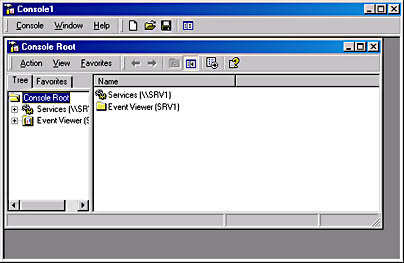
Figure 10-8. A console for remote administration.
As you can see, consoles can be configured in dozens, if not hundreds, of different ways and then distributed. Snap-ins for every imaginable function will increasingly be available from Microsoft as well as third-party suppliers.
![]()
NOTE
Because consoles are excellent tools for organizing and delegating administrative chores, examples of their use can be found in many other chapters of this book.
EAN: 2147483647
Pages: 366